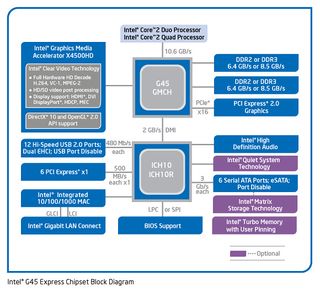G45 And GeForce 9400: Integrated Chipsets For Core 2
Intel G45 Express Chipset
Intel’s G45 was released last year as part of the 4-series chipset family. While the P45 and P43 are discrete chipset solutions, the G45, G43, and G41 are the models with integrated graphics. The G41 and G43 are limited to 8 GB of RAM and they don’t support 1080p/i HD video acceleration. The G41 only has eight instead of 12 USB 2.0 ports, and four rather than six SATA/300 ports, due to the ICH7 southbridge; all other 4-series chipsets are based on the ICH10. The P45 and P43 only differ in the way they support PCIe graphics: the P45 can divide its 16 lanes across two physical x16 slots for dual graphics, which is a must-have for enthusiasts.

Details
The G45 is built on Intel’s 65 nm manufacturing process, while the 3-series chipsets were still manufactured at 90 nm. The P45 is rated at a TDP of 22 W and it is rather interesting that the graphics-added model G45 is only two watts above that. Keep in mind that these numbers do not include the TDP for the ICH10 southbridge, which is rated at 4.5 W; it is not a 65 nm part. Both components connect via Intel’s proprietary Direct Media Interface (DMI), which is based on PCI Express and provides a total bandwidth of 2 GB/s.
Memory Support
All 4-series chipsets support either DDR2 or DDR3 memory, and it’s up to the motherboard manufacturer to design their boards for one or the other—or both, though that requires more memory sockets. It’s not possible to utilize DDR2 and DDR3 at the same time on hybrid motherboards. Both test motherboards we received are based on DDR2 memory for cost reasons, as the performance difference is negligible unless DDR3 memory is operated at speeds of DDR3-1600 or higher. 8 GB is the memory limit, and ECC is not supported.
Processor Support
All Socket 775 processors based on the Core 2 architecture are supported. This includes the recent Celeron E1000 Dual Cores, Pentium Dual Core E2000 and up, the Core 2 Duo E4000-E8000, and all Core 2 Quad processors up to the Extreme Edition. The last of these requires the motherboard to specifically support these models, as the power consumption exceeds the typical thermal envelopes of 65-95 W, reaching up to 130 W.
Stay On the Cutting Edge: Get the Tom's Hardware Newsletter
Join the experts who read Tom's Hardware for the inside track on enthusiast PC tech news — and have for over 25 years. We'll send breaking news and in-depth reviews of CPUs, GPUs, AI, maker hardware and more straight to your inbox.
The G45 with ICH10 supports RAID 0, 1, and 0+1, and RAID 5 if the ICH10R is used. Six PCIe lanes and six SATA/300 ports with AHCI and NCQ support, as well as 12 USB 2.0 ports, provide excellent connectivity. HD audio and a Gigabit network interface are mandatory today and included as well.
Video Acceleration and Graphics
Intel says the chipset assists the CPU in decoding Full HD H.264, VC-1, and MPEG-2 video, which it does well. We found a CPU load of 6.2% with a Core 2 Quad Q9550s (2.83 GHz) and 8.85% on a Core 2 Quad Q8200s (2.33 GHz). The graphics unit is based on ten unified shaders, which run at 800 MHz clock speed and access up to 512 MB of the main memory. Note that while this is better and faster than all previous generation, it is still insufficient to even remotely match pace with discrete graphics solutions.
Current page: Intel G45 Express Chipset
Prev Page Intel Or Nvidia? Next Page Intel Desktop Board DG45IDMost Popular



